ASUS ZenBook S13 UX392 review – the modern ultrabook with a designer-grade display
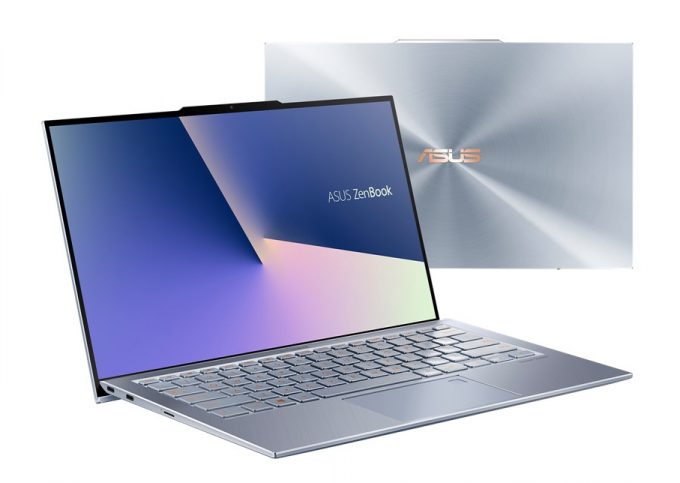 Yes, guys, an all-metal, finely crafted design is absolutely possible on a laptop. No, ASUS didn’t pay us to say that, because it is only the truth – the ASUS ZenBook S13 UX392 is gorgeous on the outside, and has the punch on the inside.
Yes, guys, an all-metal, finely crafted design is absolutely possible on a laptop. No, ASUS didn’t pay us to say that, because it is only the truth – the ASUS ZenBook S13 UX392 is gorgeous on the outside, and has the punch on the inside.
Don’t let the “13” in the name fool you, though. This is a 13.9″ laptop that is smaller than most of the 13-inch devices on the market. It weighs 1100 grams and is only 12.9mm thin. What impressed us more, however, is the fact that ASUS has put a Core i7-8565U (in our configuration) and paired it with an NVIDIA GeForce MX150… in 12.9 millimeters of thickness and 97% screen to body ratio.
This is not meant to work. Despite that, we are going to test it and see how much of a good (or bad) work has ASUS did making this notebook. Moreover, we are particularly interested in testing it against the Lenovo Ideapad S940, which as similar measurements and price tag.
You can check the prices and configurations in our Specs System: https://laptopmedia.com/series/asus-zenbook-s13-ux392/
Contents
Specs Sheet
- Display
- 13.9", FHD (1920x1080), IPS
- HDD/SSD
- up to 2000GB SSD
- M.2 Slot
- 1x 2280 PCIe NVMe 3.0 x4 See photo
- RAM
- up to 16GB
- OS
- Windows 10 Pro, Windows 10 Home, Windows OS
- Battery
- 50Wh, 3-cell
- Body material
- Aluminum
- Dimensions
- 316 x 195 x 12.9 mm (12.44" x 7.68" x 0.51")
- Weight
- 1.10 kg (2.4 lbs)
- Ports and connectivity
- 2x USB
- 3.2 Gen 2 (10 Gbps), DisplayPort, Sleep and Charge
- 1x USB Type-A
- 3.2 Gen 2 (10 Gbps)
- Card reader
- microSD
- Wi-Fi
- 802.11ac
- Bluetooth
- 5.0
- Audio jack
- Headphone/ Microphone combo
- Features
- Fingerprint reader
- Web camera
- HD
- Backlit keyboard
- Microphone
- Array microphone with Cortana voice-recognition support
- Optical drive
- Security Lock slot
All ASUS ZenBook S13 UX392 configurations
What’s in the box?
Certainly, a laptop of this caliber should have decent packaging. This is why ASUS gives you the ZenBook S13 UX392 within a black cardboard box, that looks, feels and smells premium. Well… the good smell is probably from the toilet paper the delivery guy had in his truck, but we are digressing. So, to power the thing up, there is a 65W power brick which in size is somewhere between an iPad and a MacBook charger. Moreover, there is something inside that would make Apple be ashamed – a USB Type-C dongle, that has three ports – a Type-C DC-in, an HDMI connector and a USB Type-A port. Optionally, you can get an RJ-45 dongle, as well.
Design and construction
So, without needing to tell that this laptop can be served as an example to Apple, let’s check out its quality of the build. First, let’s take a look at the device as a whole. As we mentioned, it is built out of aluminum. Its lid has the distinctive circular finish for its ZenBook legacy. Its weight of 1.10 kg and 12.9 mm profile makes it one of the most portable 14-ish inch devices. Additionally, it is a little edgy on the sides and features chamfered edges.
Quite interestingly, its lid can be opened with a single hand, although, it is not surprising by any means since the UX333, UX433, and UX533 can do that as well. It features the same ErgoLift hinge seen on the aforementioned, and it has three main purposes. First, the elevated backside of the base makes it breathe air easier. Second – you get an (arguably) more comfortable typing experience and not on the last place – it is the main reason behind the crazy screen-to-body ratio.
Down at the base, there is a decent keyboard. It has fairly large keycaps, as well as relatively long (especially for the form factor) key travel and good tactile feedback. As a downside, we should put the narrow arrow keys, which are quite uncomfortable to use. Further below, there is the touchpad of the laptop. It is made out of glass and has a fingerprint sensor embedded inside of it. Traditionally, this type of design means you won’t be able to use the area around the sensor, as it is not touch-sensitive at all – this device is not an exclusion.
Let’s turn the laptop upside down and pay attention to the ventilation grill and the two speaker cut-outs.
Ports
So, why would one need a dongle inside the box? Well, because they are lacking some essentials. On the left side, you can only see two USB Type-C 3.1 (Gen. 2) ports (one of which is used for charging), as well as a MicroSD card reader. Then on the right, there is just a single USB Type-A 31. (Gen. 2) port and a headphone jack. This is where the included dongle comes in to place – at the expense of one USB Type-C port, you get a USB Type-A one and an HDMI connector… and apparently it serves as a passthrough for the power to be plugged in, as there is one USB Type-C port as well, which is labeled “DC-in”. Sadly, none of the aforementioned USB Type-C ports support Thunderbolt.
Disassembly, upgrade options and maintenance
For this part of the review, we did brace ourselves. ASUS ZenBooks have a history of hiding screws beneath their legs. Well, thankfully for us, this wasn’t the case with the ZenBook S13 UX392. What you see is everything – 8 Torx-head screws – four at the top and four at the bottom.
Its cooling comprises two pretty small fans cooling of one fairly bulky heat pipe. Interestingly, it goes all the way from the left to the right, as the fans are flanged by the processor and the graphics card. We are impressed by this design because it separates the main reasons for heat inside of a system and despite giving them a single heat pipe, the two fans in the middle should do a perfect job preventing heat from transferring from one side of the heat pipe to the other.
Upgradability is the area where this laptop just…sucks. Indeed, it has an M.2 PCIe x4 slot for extremely fast NVMe drives, but this is it. All of the RAM chips are soldered to the motherboard, so if you need the laptop for coding or RAM-intensive work, we would recommend going for the 16GB version.
On the bright side, ASUS has equipped their laptop with a sizeable battery pack with 50Wh capacity only 2Wh less than the Ideapad S940.
Display quality
Display quality
ASUS ZenBook S13 UX392 has a Full HD IPS panel, model Tianma XM TL139VDXP01. Its diagonal is 13.9-inch (35.3 cm), and the resolution – 1920 х 1080p. Additionally, the screen ratio is 16:9, the pixel density – 157 ppi, their pitch – 0.161 х 0.161 mm. The screen can be considered Retina when viewed from at least 55 cm (from this distance, the average human eye can’t see the individual pixels).
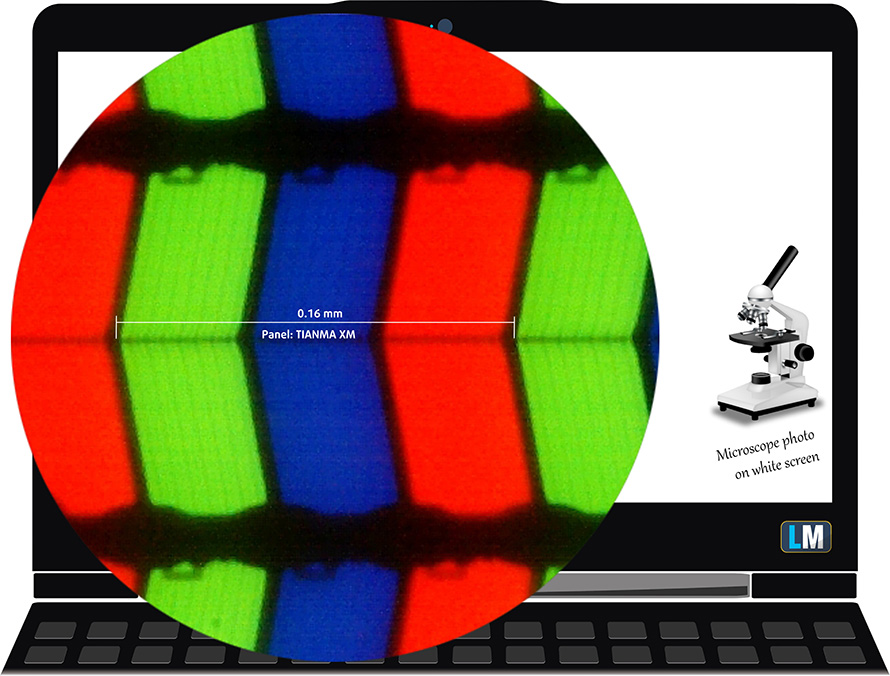
The notebook has comfortable viewing angles. We offer images at different angles to evaluate the quality.

The maximum measured brightness is 450 nits (cd/m2) in the middle of the screen and 460 nits (cd/m2) average across the surface with a maximum deviation of 13%. The Correlated Color Temperature on a white screen and at maximum brightness is 6700K – slightly colder than the 6500K temperature for sRGB. The average color temperature through the grey scale before profiling is 6900K.
In the illustration below you can see how the display performs from uniformity perspective. The illustration below shows how matters are for operational brightness levels (approximately 140 nits) – in this particular case at 31% Brightness (White level = 140 cd/m2, Black level = 0.11 cd/m2).
Values of dE2000 over 4.0 should not occur, and this parameter is one of the first you should check if you intend to use the laptop for color-sensitive work (a maximum tolerance of 2.0 ). The contrast ratio is excellent – 1450:1.
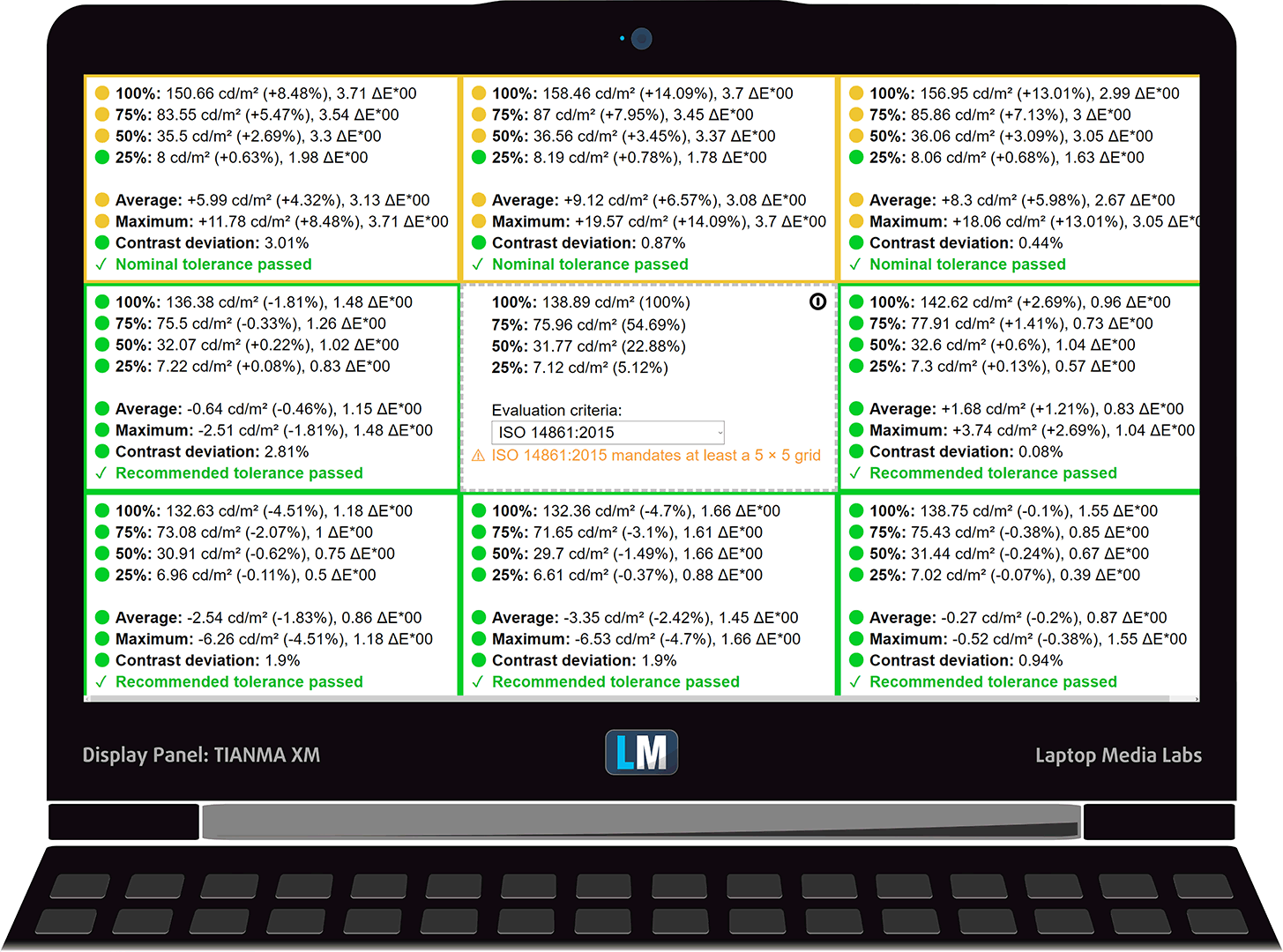
To make sure we are on the same page, we would like to give you a little introduction of the sRGB color gamut and the Adobe RGB. To start, there’s the CIE 1976 Uniform Chromaticity Diagram that represents the visible specter of colors by the human eye, giving you a better perception of the color gamut coverage and the color accuracy.
Inside the black triangle, you will see the standard color gamut (sRGB) that is being used by millions of people in HDTV and on the web. As for the Adobe RGB, this is used in professional cameras, monitors, etc for printing. Basically, colors inside the black triangle are used by everyone and this is the essential part of the color quality and color accuracy of a mainstream notebook.
Still, we’ve included other color spaces like the famous DCI-P3 standard used by movie studios, as well as the digital UHD Rec.2020 standard. Rec.2020, however, is still a thing of the future and it’s difficult for today’s displays to cover that well. We’ve also included the so-called Michael Pointer gamut, or Pointer’s gamut, which represents the colors that naturally occur around us every day.
The yellow dotted line shows ASUS ZenBook S13 UX392′ color gamut coverage.
Its display not only covers 92% of the sRGB/ITU-R BT.709 (web/HDTV standard).
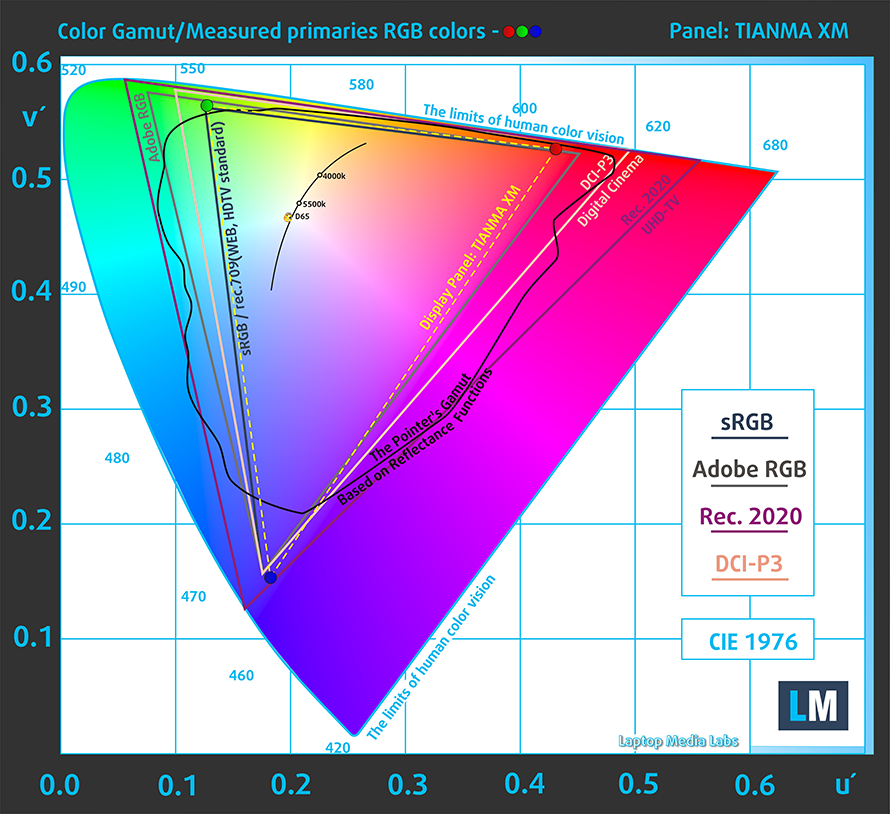
Our “Design and Gaming” profile delivers optimal color temperature (6500K) at 140 cd/m2 luminance and sRGB gamma mode.
We tested the accuracy of the display with 24 commonly used colors like light and dark human skin, blue sky, green grass, orange, etc. You can check out the results at factory condition and also, with the “Design and Gaming” profile.
Below you can compare the scores of ASUS ZenBook S13 UX392 with the default settings (left), and with the “Gaming and Web design” profile (right).
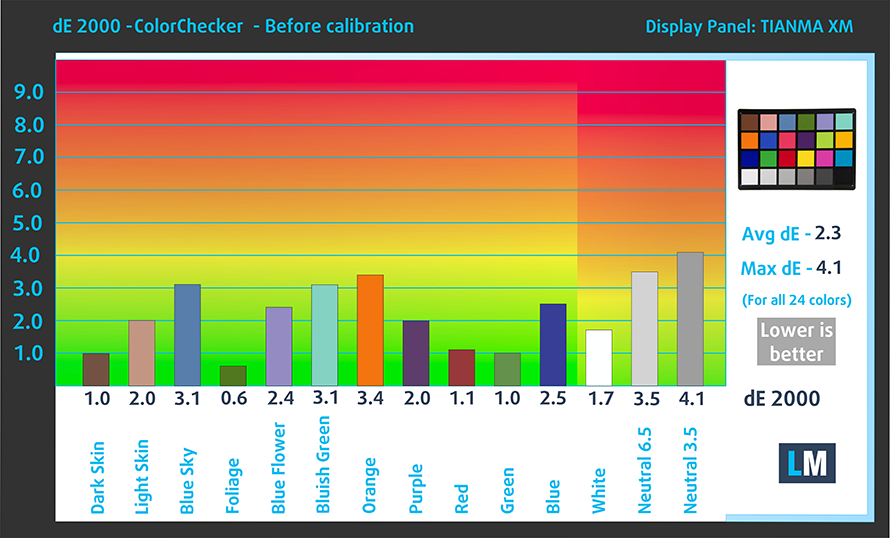
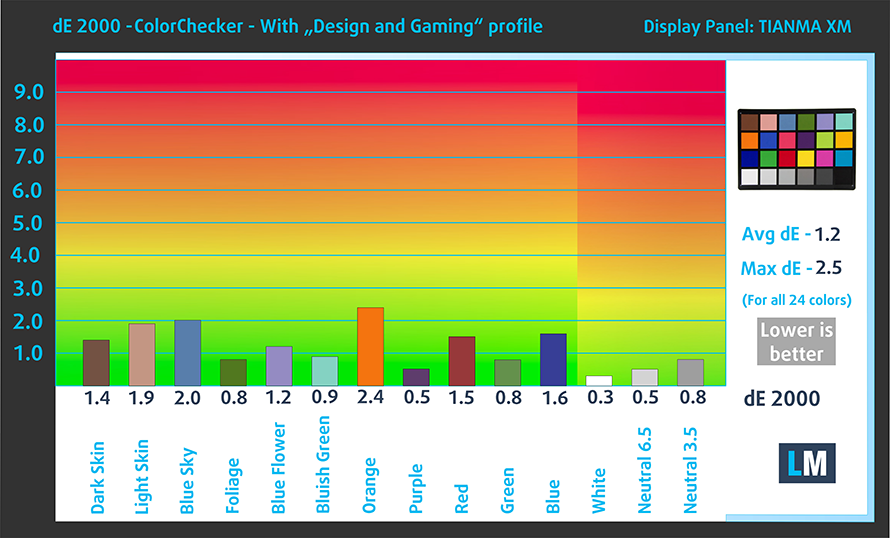
The next figure shows how well the display is able to reproduce really dark parts of an image, which is essential when watching movies or playing games in low ambient light.
The left side of the image represents the display with stock settings, while the right one is with the “Gaming and Web Design” profile activated. On the horizontal axis, you will find the grayscale and on the vertical axis – the luminance of the display. On the two graphs below you can easily check for yourself how your display handles the darkest nuances but keep in mind that this also depends on the settings of your current display, the calibration, the viewing angle, and the surrounding light conditions.
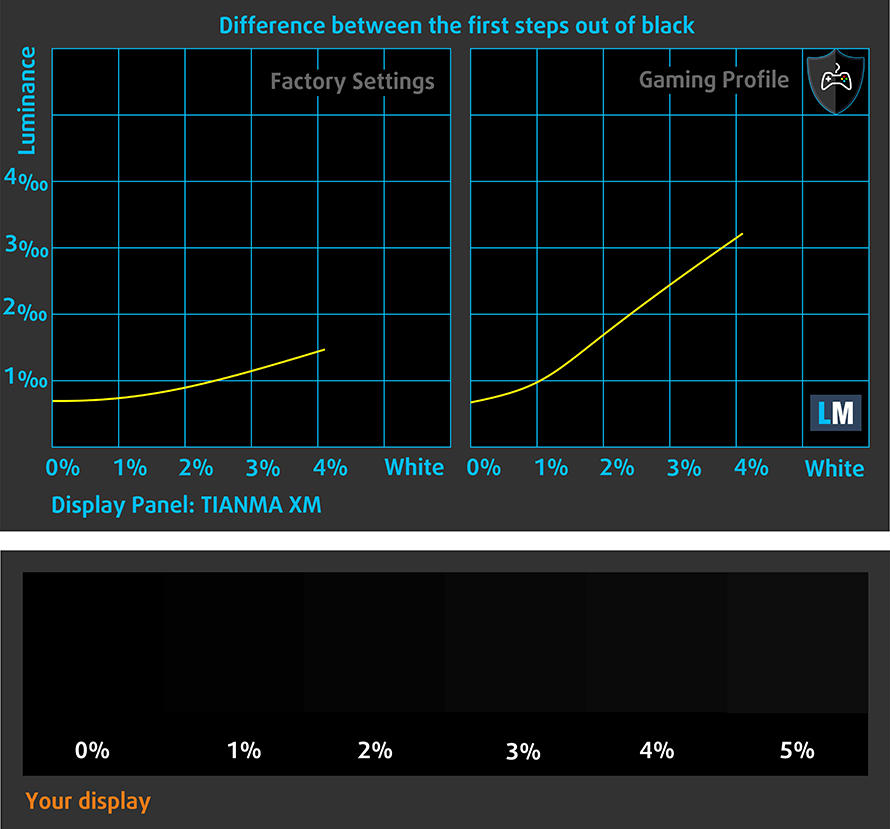
Response time (Gaming capabilities)
We test the reaction time of the pixels with the usual “black-to-white” and “white-to-black” method from 10% to 90% and vice versa.
We recorded Fall Time + Rise Time = 24 ms.
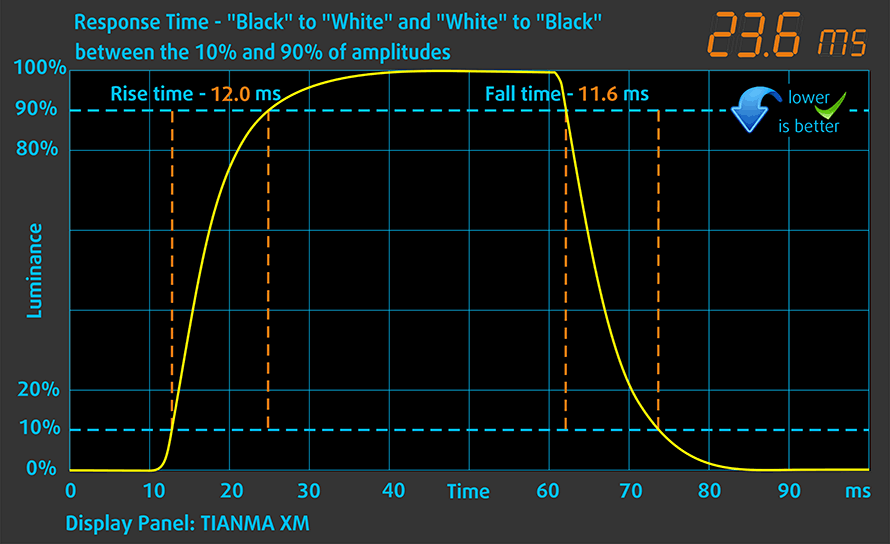
Health impact – PWM / Blue Light
PWM (Screen flickering)
Pulse-width modulation (PWM) is an easy way to control monitor brightness. When you lower the brightness, the light intensity of the backlight is not lowered, but instead turned off and on by the electronics with a frequency indistinguishable to the human eye. In these light impulses, the light/no-light time ratio varies, while brightness remains unchanged, which is harmful to your eyes. You can read more about that in our dedicated article on PWM.
ASUS ZenBook S13 UX392’s display doesn’t use PWM to adjust its brightness levels. This makes it comfortable to use for long periods of time, without harming your eyes in this aspect.
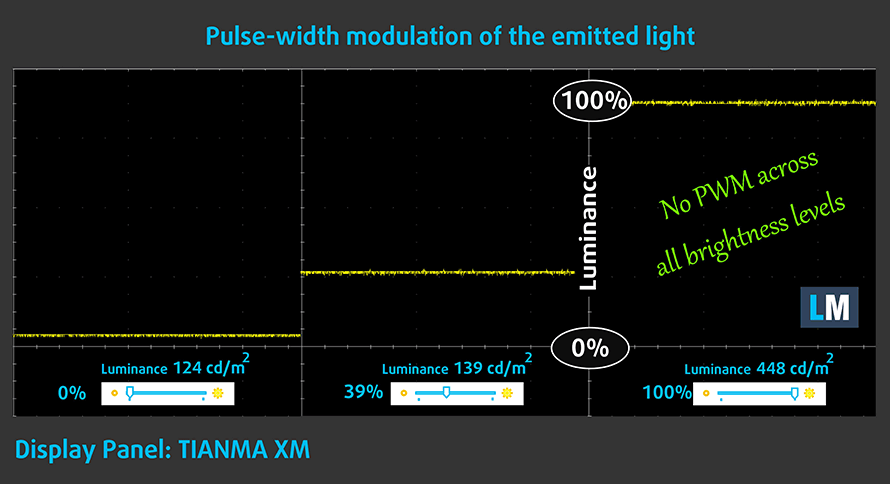
Blue light emissions
Installing our Health-Guard profile not only eliminates PWM but also reduces the harmful Blue Light emissions while keeping the colors of the screen perceptually accurate. If you’re not familiar with the Blue light, the TL;DR version is – emissions that negatively affect your eyes, skin and your whole body. You can find more information about that in our dedicated article on Blue Light.
Conclusion
ASUS ZenBook S13 UX392’s display has a Full HD IPS panel with a very high maximum brightness, good contrast ratio, comfortable viewing angles, and wide color coverage. Additionally, its backlight doesn’t flicker and the color accuracy is on point, especially, when our Gaming and Web design is present.
Buy our profiles
Since our profiles are tailored for each individual display model, this article and its respective profile package are meant for ASUS ZenBook S13 UX392 configurations with 13.9″ Tianma XM TL139VDXP01 (FHD, 1920 × 1080) IPS panel.
*Should you have problems with downloading the purchased file, try using a different browser to open the link you’ll receive via e-mail. If the download target is a .php file instead of an archive, change the file extension to .zip or contact us at [email protected].
Read more about the profiles HERE.
In addition to receiving efficient and health-friendly profiles, by buying LaptopMedia's products you also support the development of our labs, where we test devices in order to produce the most objective reviews possible.

Office Work
Office Work should be used mostly by users who spend most of the time looking at pieces of text, tables or just surfing. This profile aims to deliver better distinctness and clarity by keeping a flat gamma curve (2.20), native color temperature and perceptually accurate colors.

Design and Gaming
This profile is aimed at designers who work with colors professionally, and for games and movies as well. Design and Gaming takes display panels to their limits, making them as accurate as possible in the sRGB IEC61966-2-1 standard for Web and HDTV, at white point D65.

Health-Guard
Health-Guard eliminates the harmful Pulse-Width Modulation (PWM) and reduces the negative Blue Light which affects our eyes and body. Since it’s custom tailored for every panel, it manages to keep the colors perceptually accurate. Health-Guard simulates paper so the pressure on the eyes is greatly reduced.
Get all 3 profiles with 33% discount
Sound
ASUS ZenBook S13 UX392’s speakers produce a rich and high-quality sound with its Harman Kardon tuning. Its low, mid and high tones are clear of deviations.
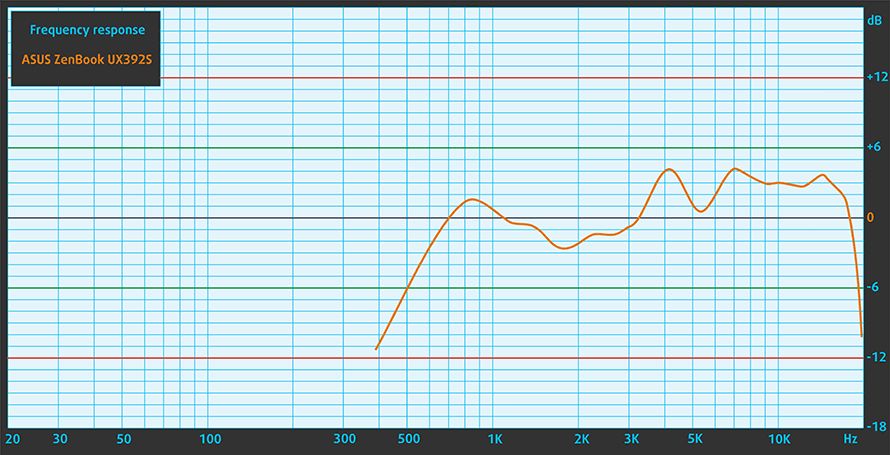
Drivers
Drivers for the ASUS ZenBook S13 UX392 can be found here: https://www.asus.com/Laptops/ASUS-ZenBook-S13-UX392FN/HelpDesk_Download/
Battery
Now, we conduct the battery tests with Windows Better performance setting turned on, screen brightness adjusted to 120 nits and all other programs turned off except for the one we are testing the notebook with. The ZenBook S13 UX392 is equipped with a 50Wh battery, which is pretty sizeable for a 13.9-inch laptop.
This was enough for a little bit less than 12 hours of Web browsing and more than 8 hours of video playback.
In order to simulate real-life conditions, we used our own script for automatic web browsing through over 70 websites.
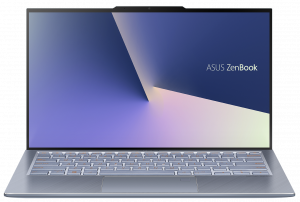
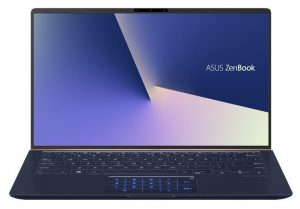

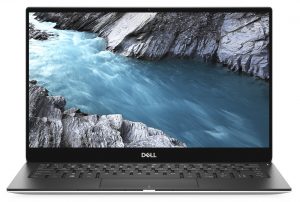
For every test like this, we use the same video in HD.




CPU options
There are two choices for you (both of them are pretty good) – the Core i5-8265U or the Core i7-8565U. They are both quad-core/octa-thread processors – the first works at a base frequency of 1.60 GHz and reaches 3.90 GHz in Turbo, while the latter goes from 1.80 GHz up to 4.60 GHz in Turbo.
Results are from the Cinebench 20 CPU test (the higher the score, the better)
Results are from our Photoshop benchmark test (the lower the score, the better)
GPU options
In addition to the Intel UHD Graphics 620, you get the NVIDIA GeForce MX150 with 2GB of GDDR5 memory. However, it is the 10W version, so expect a slightly slower performance than the 25W one.
Results are from the 3DMark: Fire Strike (Graphics) benchmark (higher the score, the better)
Results are from the Unigine Superposition benchmark (higher the score, the better)
Gaming tests

| CS:GO | HD 1080p, Low (Check settings) | HD 1080p, Medium (Check settings) | HD 1080p, MAX (Check settings) |
|---|---|---|---|
| Average FPS | 99 fps | 84 fps | 62 fps |

| DOTA 2 | HD 1080p, Low (Check settings) | HD 1080p, Normal (Check settings) | HD 1080p, High (Check settings) |
|---|---|---|---|
| Average FPS | 120 fps | 76 fps | 52 fps |
Temperatures and comfort
Max CPU load
In this test we use 100% on the CPU cores, monitoring their frequencies and chip temperature. The first column shows a computer’s reaction to a short load (2-10 seconds), the second column simulates a serious task (between 15 and 30 seconds), and the third column is a good indicator of how good the laptop is for long loads such as video rendering.

Average core frequency (base frequency + X); CPU temp.
| Intel Core i7-8565U (15W TDP) | 0:02 – 0:10 sec | 0:15 – 0:30 sec | 10:00 – 15:00 min |
|---|---|---|---|
| ASUS ZenBook S13 UX392 | 3.04 GHz (B+69%)@ 72°C | 2.98 GHz (B+66%)@ 91°C | 2.24 GHz (B+24%)@ 73°C |
| Lenovo Ideapad S940 | 3.01 GHz (B+67%)@ 90°C | 2.40 GHz (B+33%)@ 92°C | 1.81 GHz @ 79°C |
| Acer Swift 5 (SF515-51T) | 1.98 GHz (B+10%)@ 61°C | 1.98 GHz (B+10%)@ 71°C | 1.68 GHz @ 77°C |
| Dell Inspiron 15 7580 | 2.23 GHz (B+23%)@ 72°C | 2.22 GHz (B+22%)@ 73°C | 2.24 GHz (B+24%)@ 73°C |
| Dell Inspiron 14 5482 2-in-1 | 3.12 GHz (B+73%)@ 96°C | 2.56 GHz (B+42%)@ 94°C | 2.01 GHz (B+12%)@ 76°C |
It is clear that the ZenBook S13 UX392 has sufficient cooling. It started the test very strongly at 3.04 GHz, while the temperature for that space of time was the only 72C. We noticed that the fans were either spinning very slowly or not spinning at all since the laptop was very quiet at that part. Then, the temperature reached 91C – the highest throughout the entire test – we started hearing the fans speed up a little bit. By the time the test ended, they were pretty audible, while the temperatures have fallen into the low 70s and the frequency to 2.24 GHz. It performed significantly better than the Lenovo Ideapad S940.
Real-life gaming
| GPU frequency/ Core temp (after 2 min) | GPU frequency/ Core temp (after 30 min) | |
|---|---|---|
| ASUS ZenBook S13 UX392 | 1177 MHz @ 64°C | 1177 MHz @ 66°C |
| Xiaomi Notebook Air 13 | 1264 MHz @ 65°C | 1236 MHz @ 73°C |
As we mentioned, the laptop is equipped with the 10W version of the MX150. This means it will produce a lot less heat, but it will perform slightly worse than the 25W model. Above, you can see a comparison to the Xiaomi Notebook Air 13, which runs warmer, but at slightly higher frequency. Note that both of them are 10W units.
Comfort during full load
This laptop ran a little warm on both upper sides of the chassis. This is due to the thin design. Now you understand what we meant about putting the CPU and the GPU in separate corners of the machine.
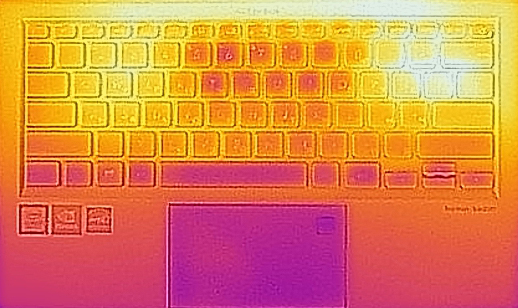

Verdict
 At the beginning of this review, we mentioned that the ZenBook S13 UX392 would be put in the league of Lenovo Ideapad S940 – both in terms of its form factor and performance. In order to compare two devices, you need to first find similarities. So, what is common between the two? Well, first, there is the design. Both of them have 14-inch or near displays, they are made out of aluminum and are crazy thin and light.
At the beginning of this review, we mentioned that the ZenBook S13 UX392 would be put in the league of Lenovo Ideapad S940 – both in terms of its form factor and performance. In order to compare two devices, you need to first find similarities. So, what is common between the two? Well, first, there is the design. Both of them have 14-inch or near displays, they are made out of aluminum and are crazy thin and light.
So which manufacturer pulled it off better? First, you can check our take on the Ideapad S940, we’re going to wait… Are you ready? Let’s begin then. The ZenBook S13 UX392 offers you a great performance from its CPU. No, for real, it is probably the second-best Core i7-8565U performer, after the 15-inch ZenBook 15 UX533, of course.
So, theoretically, you should be able to do even some light video rendering on it, without problems. As of the display, we are soon going to be ready with our tests and will update the article. While the sound it produces is not the loudest, it has good dynamics and quality with distinguishable lows and mids and pretty clear high tones.
Design-wise, this laptop is unprecedented. It is one of the lightest laptops ASUS has ever produced with its 1.10 kg body weight and 12.9mm profile. Additionally, it has an astonishing screen-to-body ratio thanks to the ErgoLift hinge and some black magic. Speaking of the screen – our unit’s 1080p IPS panel (Tianma XM TL139VDXP01) had a very high maximum brightness, great contrast ratio and covered 92% of sRGB. Moreover, it doesn’t flicker at any brightness level, and it has a very good color accuracy, which is further boosted by our Gaming and Web design, making the laptop appropriate for Web and graphic designers. All in all, it feels premium and costs premium as well…
One of the major shortcomings of this laptop is sadly its upgradability. While you can easily upgrade your M.2 SSD by just popping that bottom panel open, you are limited to pretty much that. Its RAM is soldered to the motherboard, so be sure you pick the right version for your needs.
Additionally, it is a little short on I/O, as well, despite the fact that ASUS was still able to put a USB Type-A port. It also lacks Thunderbolt support. Thankfully, it has a dongle inside the box (make notes, Apple), that has a Type-C charging passthrough, an HDMI connector, and an additional USB Type-A port.
We want to finish this review with battery life. Its 50Wh battery was enough for around 12 hours of Web browsing and more than 8 hours of video playback. This means that your device will surely last through an entire workday on battery power, and will last you a full season of Game of Thrones on the next charge.
This caps up our views on the ASUS ZenBook S13 UX392. Tell us in the comments, how keen are you on getting this device and whether you prefer it to something like the Lenovo Ideapad S940 or the Dell XPS 13 9380.
Pros
- One of the finely crafted laptops on the market
- All-aluminum body
- Impressive performance
- Incredibly narrow bezels
- Super thin (12.9mm) and light (1.10 kg)
- Super bright panel, that doesn’t flicker at any level (Tianma XM TL139VDXP01)
- Wide color coverage (92% of sRGB) and great color accuracy, especially with our Gaming and Web design profile (Tianma XM TL139VDXP01)
Cons
- Poor upgradability
- Limited I/O, although it includes a dongle inside the box
- Lacks Thunderbolt support
You can check the prices and configurations in our Specs System: https://laptopmedia.com/series/asus-zenbook-s13-ux392/
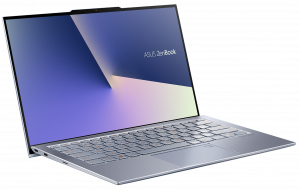
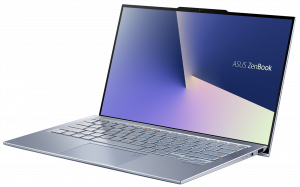
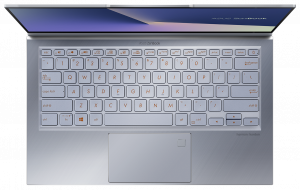
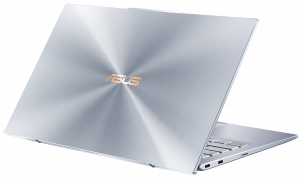
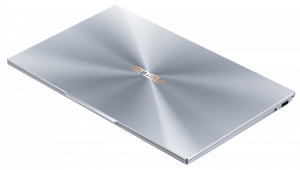
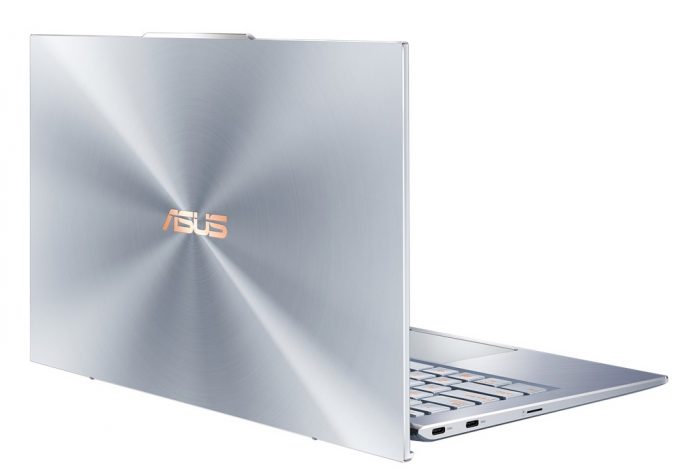
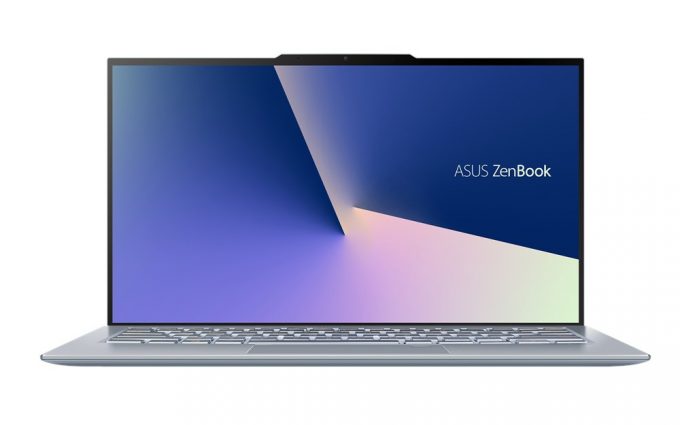
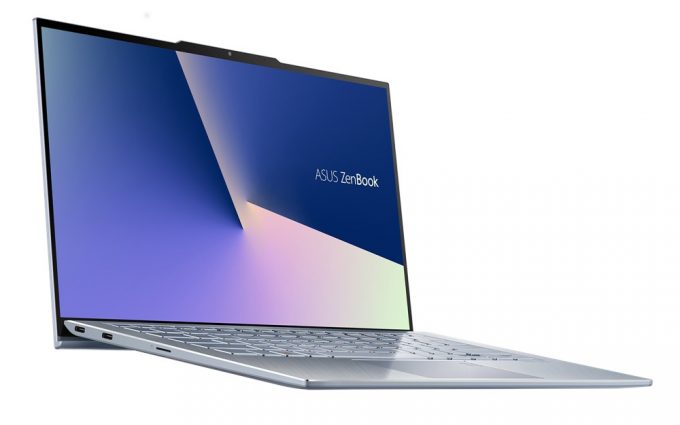
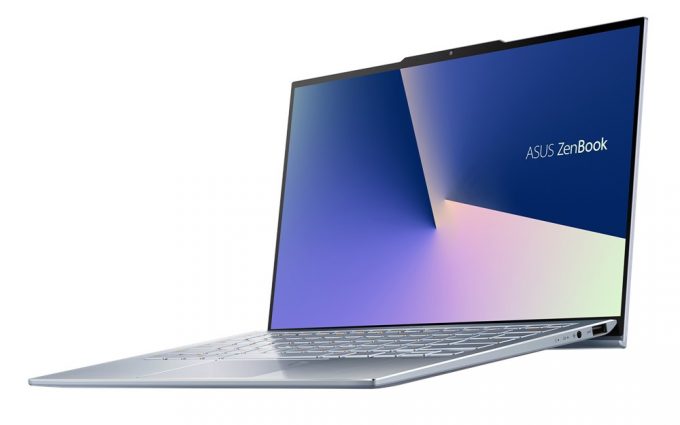


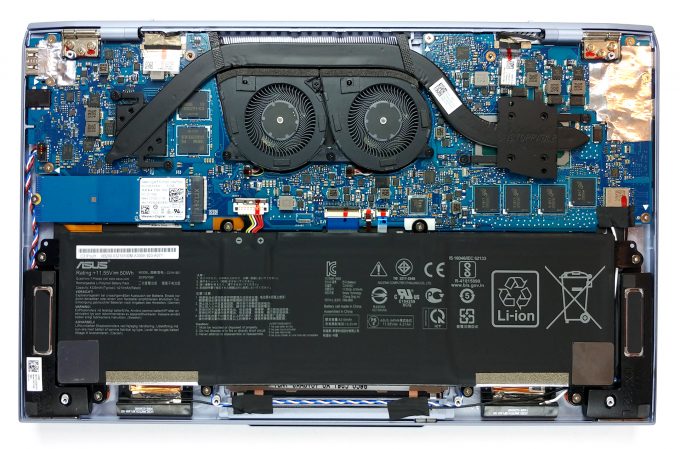
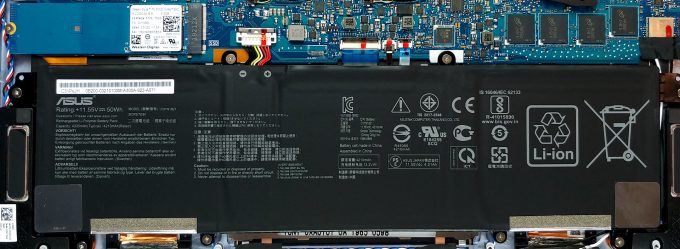


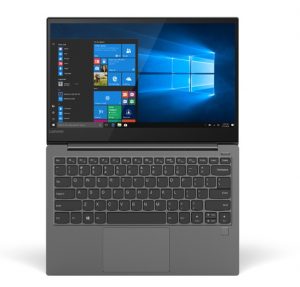








If only they make a 15 or 17 inch version. 🙁
There is a 15 inch version, the UX533 and UX534